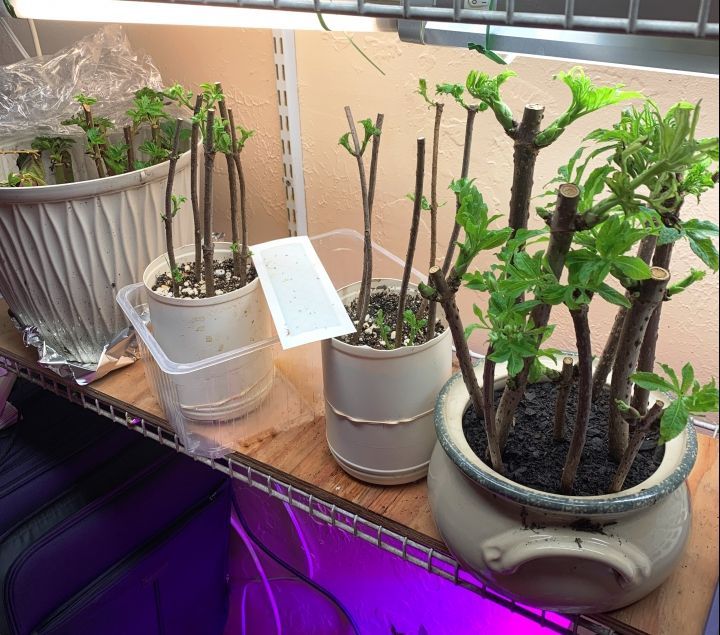

The walk-in cooler has been complete for some time as well as the addition of some settling filter tanks in the system. The typical greenhouse two-layer plastic with air pumped between the layers has been sufficient insulation for the most part. During particularly cold spells we have occasionally added a 1000 watt bucket heater to help maintain water temps for the fish when the water temps are headed below fifty degrees. We also have two solar water heater panels that we were usng to maintain water temps in winter, but found the copper piping to be detrimental to the fish. We have bought a stainless steel heat exchange coil and a high temperature water pump but have not yet installed them.
The aqua house plastic fabric finally needed replacing (after about ten years, end of 2022). There were some building design flaws that allowed too much moisture to accumulate on the wood framing, which also required replacement. So we took this 'opportunity' to rebuild the aqua house. We now have much larger vent areas, much larger main wood beams on the ends, aluminum sheeting to cover most of the wood where moisture accumulates, and a bit of rewiring for all of the sensors. We have added screens to some of the vent doors but they still need some work.
As the Aquaponics is only part of our overall farm plan, we have improved in other areas such as the installation of solar panels and the start of a large quantity of tea seedlings. If you have wandered around our tea information, you will likely know that it has been ... uhhh ... lets just say sub-optimal. Ninety to ninety-five percent of all tea planted outdoors has been decimated by underground critters eating the roots. Voles, we assume. As we will not grow or sell food with chemicals, our attempts to eliminate them has not worked at all.
As a (very) long range plan, we are still considering clearing an area of the hillside behind the residence for some expanded Aquaponics construction. Unless we get a reliable income from something on the farm, that idea will remain untenable. The alternate plan to create some plots of tea up there did not do well as our first two planted areas were decimated by voles or gophers as already mentioned.
So, on to something new ... ish. We are converting the lower insulated barn room to grow indoor mushrooms. So far it is wired, vented and the ceiling mostly sealed up. We are working on cleaning the floor and walls. It has been washed down with water. We next need to do some scraping of concrete bits from the floor, seal up the door, and then clean the entire room with peroxide. Initial mushrooms will be the easiest to grow, oysters. We have also taken down some smaller Red Alder trees in the back field area to innoculate with shitake spawn for an outdoor grow.
In the meantime, we also purchased a number of rolls of 1/4" mesh hardware cloth of both galvanized and stainless steel wire. We have dug our first bed that is two feet deep, eight feet wide and 46 feet long to be lined with the hardware cloth. Once it is lined we will refill it and plant out as many tea plants as will fit in the bed. Since the tea plants takes at least five to seven years to mature and shade out the entire bed, we will plant annuals or short lived perennials between the tea plants. The first few beds will be inside the fenced orchard area. Hopefully this will let us finally grow some mature tea plants. Of course, nobody could tell us if galvanized cloth was a problem. We had avoided it in the past. But the extension service could find no studies to indicate that it may be dangerous. In addition, the organic certifiers have no indication that it cannot be used in organic production. The only caveat is that we will need to keep testing our plants to make sure. You would think SOMEBODY would have done that already!

| Our albums of construction pictures are available here. |

| Our album of more general pictures of our forested farm property is available at this link to our Gophercreek website . |
Terms of Service Privacy Policy
(with 579 cited references)
Find out about: America's (now the World's) Favorite Poison By Far!
... " just four companies — Bayer, Corteva (formerly DowDuPont), BASF and Syngenta/ChemChina — controlled 75 percent of plant breeding research, 60 percent of the commercial seed market, and 76 percent of global agrichemical sales in 2019."[78]
Monsanto / Bayer's Roundup Triggers Over 40 Plant Diseases and Endangers Human and Animal Health. Protect yourself and those you care about!
http://www.i-sis.org.uk/argentinasRoundupHumanTragedy.php
http://www.NaturalNews.com/031138_Monsanto_Roundup.html
[78] ETC Group. (2019, April 06). New report: Putting the cartel before the horse…and farm, seeds, soil, peasants. https://www.etcgroup.org/content/new-report-putting-cartel-horse%E2%80%A6and-farm-seeds-soil-peasants
|
Just Say No To GMO by Michael Adams - Video
https://www.naturalnews.com/NoGMO.html Just Say No To GMO by Michael Adams - Music https://oregonTruffleTryst.com/_MEDIA/JustSayNoToGMO-192.mp3 Song Lyrics
|